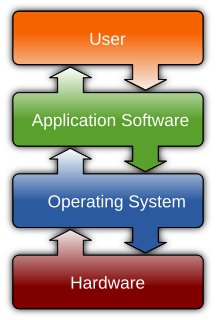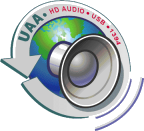
Computer software, or simply software, is a collection of data or computer instructions that tell the computer how to work. This is in contrast to physical hardware, from which the system is built and actually performs the work. In computer science and software engineering, computer software is all information processed by computer systems, programs and data. Computer software includes computer programs, libraries and related non-executable data, such as online documentation or digital media. Computer hardware and software require each other and neither can be realistically used on its own.
In computing, a device driver is a computer program that operates or controls a particular type of device that is attached to a computer. A driver provides a software interface to hardware devices, enabling operating systems and other computer programs to access hardware functions without needing to know precise details about the hardware being used.
Trusted Computing (TC) is a technology developed and promoted by the Trusted Computing Group. The term is taken from the field of trusted systems and has a specialized meaning. With Trusted Computing, the computer will consistently behave in expected ways, and those behaviors will be enforced by computer hardware and software. Enforcing this behavior is achieved by loading the hardware with a unique encryption key inaccessible to the rest of the system.
In computing, the Windows Driver Model (WDM) – also known at one point as the Win32 Driver Model – is a framework for device drivers that was introduced with Windows 98 and Windows 2000 to replace VxD, which was used on older versions of Windows such as Windows 95 and Windows 3.1, as well as the Windows NT Driver Model.
In computing, a class driver is a type of hardware device driver that can operate a large number of different devices of a broadly similar type.
The Media Transfer Protocol (MTP) is an extension to the Picture Transfer Protocol (PTP) communications protocol that allows media files to be transferred atomically to and from portable devices. Whereas PTP was designed for downloading photographs from digital cameras, Media Transfer Protocol allows the transfer of music files on digital audio players and media files on portable media players, as well as personal information on personal digital assistants. MTP is a key part of WMDRM10-PD, a digital rights management (DRM) service for the Windows Media platform.
SMPTE 421M, informally known as VC-1, is a video coding format. Most of it was initially developed as the proprietary video format Windows Media Video 9 by Microsoft in 2003. With some enhancements including the development of a new Advanced Profile, it was officially approved as a SMPTE video codec standard on April 3, 2006.

The architecture of Windows NT, a line of operating systems produced and sold by Microsoft, is a layered design that consists of two main components, user mode and kernel mode. It is a preemptive, reentrant operating system, which has been designed to work with uniprocessor and symmetrical multiprocessor (SMP)-based computers. To process input/output (I/O) requests, they use packet-driven I/O, which utilizes I/O request packets (IRPs) and asynchronous I/O. Starting with Windows XP, Microsoft began making 64-bit versions of Windows available; before this, these operating systems only existed in 32-bit versions.

The Trusted Computing Group is a group formed by AMD, Hewlett-Packard, IBM, Intel and Microsoft to implement Trusted Computing concepts across personal computers. The Trusted Computing Group was announced in 2003 as the successor to the Trusted Computing Platform Alliance which was previously formed in 1999. Many other companies have since joined the Trusted Computing Group, including Wave Systems Corp, Digital Management, Inc., Cisco, Lenovo, Infineon, Juniper Networks and Fujitsu.
The Apple–Intel architecture, or Mactel, is an unofficial name used for Apple Macintosh personal computers developed and manufactured by Apple Inc. that use Intel x86 processors, rather than the PowerPC and Motorola 68000 ("68k") series processors used in their predecessors. With the change in architecture, a change in firmware became necessary; Apple selected the Intel-designed Extensible Firmware Interface (EFI) as its comparable component to the Open Firmware used on its PowerPC architectures, and as the firmware-based replacement for the PC BIOS from Intel. With the change in processor architecture to x86, Macs gained the ability to boot into x86-native operating systems, while Intel VT-x brought near-native virtualization with Mac OS X as the host OS.

BitLocker is a full volume encryption feature included with Microsoft Windows versions starting with Windows Vista. It is designed to protect data by providing encryption for entire volumes. By default, it uses the AES encryption algorithm in cipher block chaining (CBC) or XTS mode with a 128-bit or 256-bit key. CBC is not used over the whole disk; it is applied to each individual sector.

Universal Audio Architecture (UAA) is an initiative unveiled in 2002 by Microsoft to standardize the hardware and class driver architecture for audio devices in modern Microsoft Windows operating systems. Three classes of audio devices are supported by default: USB, IEEE 1394 (Firewire), and Intel High Definition Audio, which supports PCI and PCI Express.
Windows Vista, an operating system released by Microsoft for consumers on January 30, 2007, has been widely criticized by reviewers and users. Due to issues with new security features, performance, driver support and product activation, Windows Vista has been the subject of a number of negative assessments by various groups.
The Protected Media Path is a set of technologies creating a "Protected Environment," first included in Microsoft's Windows Vista operating system, that is used to enforce digital rights management protections on content. Its subsets are Protected Video Path (PVP) and Protected User Mode Audio (PUMA). Any application that uses Protected Media Path in Windows uses Media Foundation.
The various versions of Microsoft's desktop operating system, Windows, have received many criticisms since Microsoft's inception.
Compliance and Robustness, sometimes abbreviated as C&R, refers to the legal structure or regime underlying a Digital Rights Management (DRM) system. In many cases, the C&R regime for a given DRM is provided by the same company that sells the DRM solution. For example, RealNetworks Helix or Microsoft Windows Media DRM.
Tagès was a software copy protection system, jointly developed, at first, by MPO and the Thales Group starting in 1999. Its method of protection has since been described as twin sectors.
A hardware restriction is content protection enforced by electronic components. The hardware restriction scheme may complement a digital rights management system implemented in software. Some examples of hardware restriction information appliances are video game consoles, smartphones, tablet computers, Macintosh computers and personal computers that implement secure boot.

Microsoft Product Activation is a DRM technology used by Microsoft Corporation in several of its computer software programs, most notably its Windows operating system and its Office productivity suite. The procedure enforces compliance with the program's end-user license agreement by transmitting information about both the product key used to install the program and the user's computer hardware to Microsoft, inhibiting or completely preventing the use of the program until the validity of its license is confirmed.
A trusted execution environment (TEE) is a secure area of a main processor. It guarantees code and data loaded inside to be protected with respect to confidentiality and integrity. A TEE as an isolated execution environment provides security features such as isolated execution, integrity of applications executing with the TEE, along with confidentiality of their assets. In general terms, the TEE offers an execution space that provides a higher level of security than a rich mobile operating system open and more functionality than a 'secure element' (SE).








